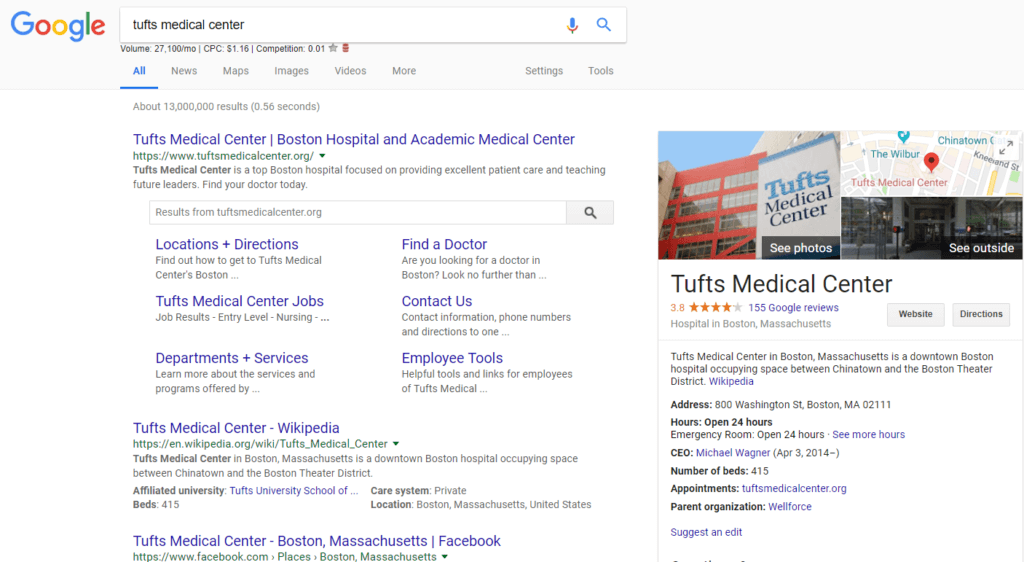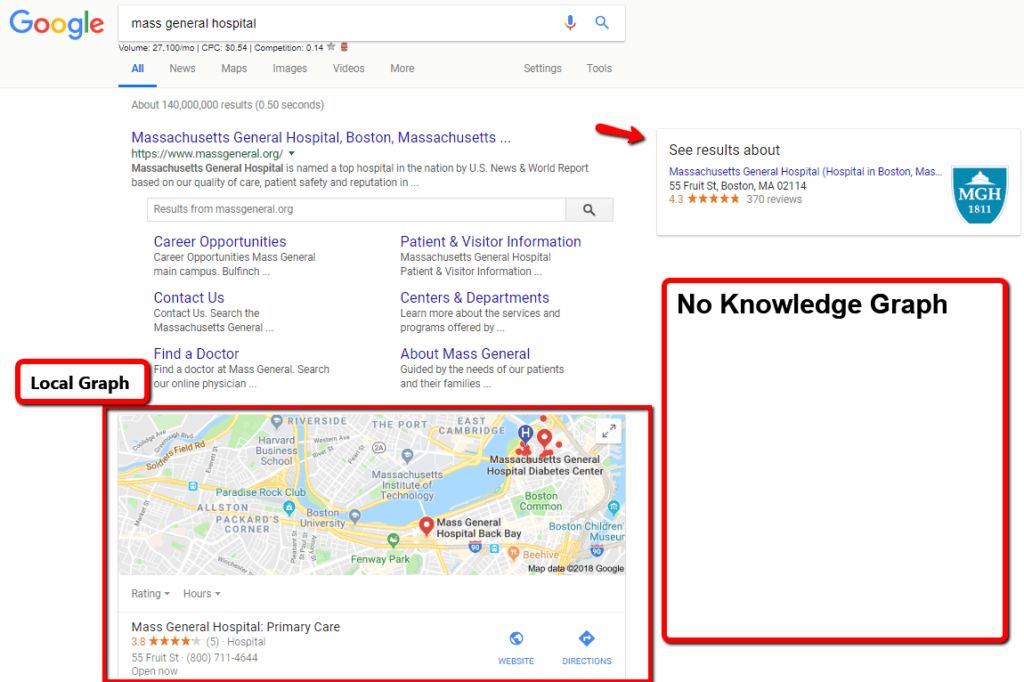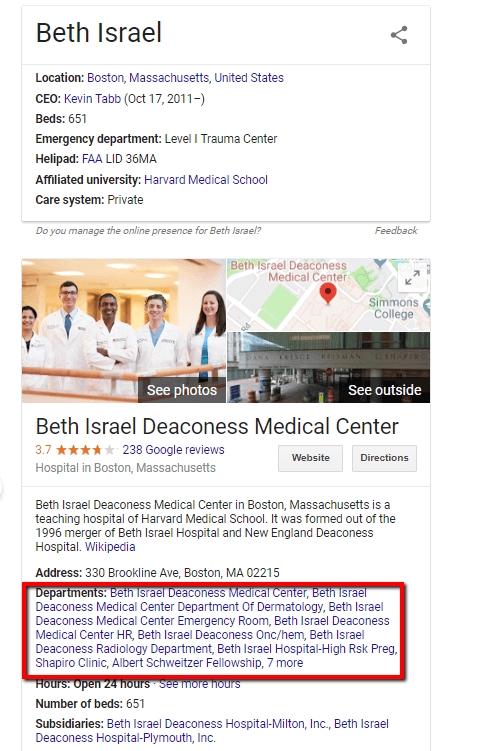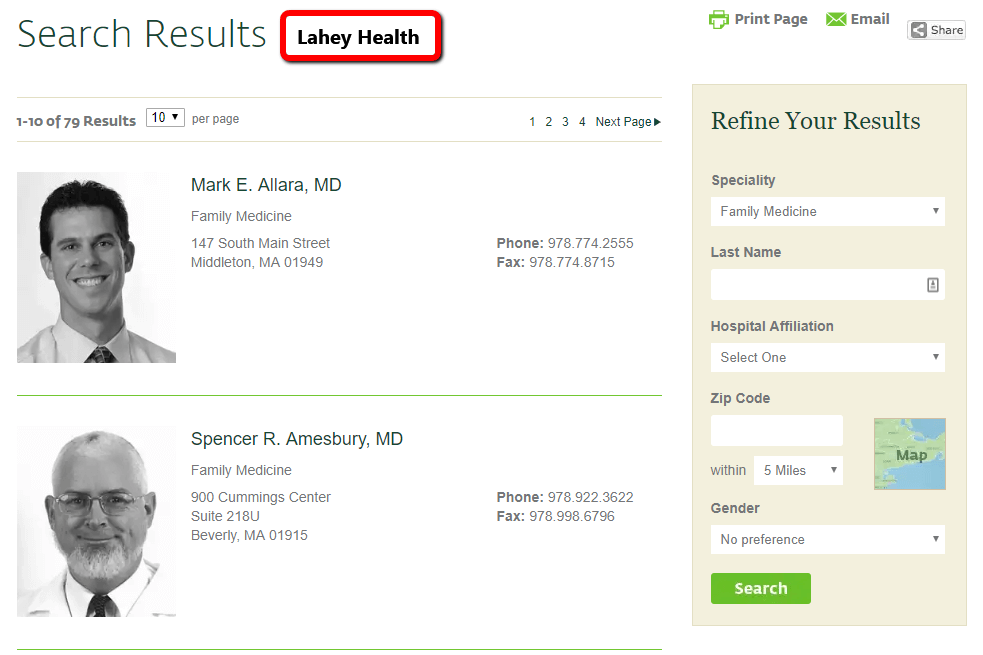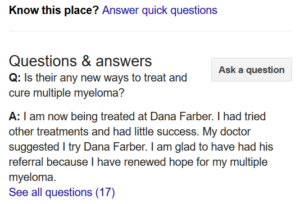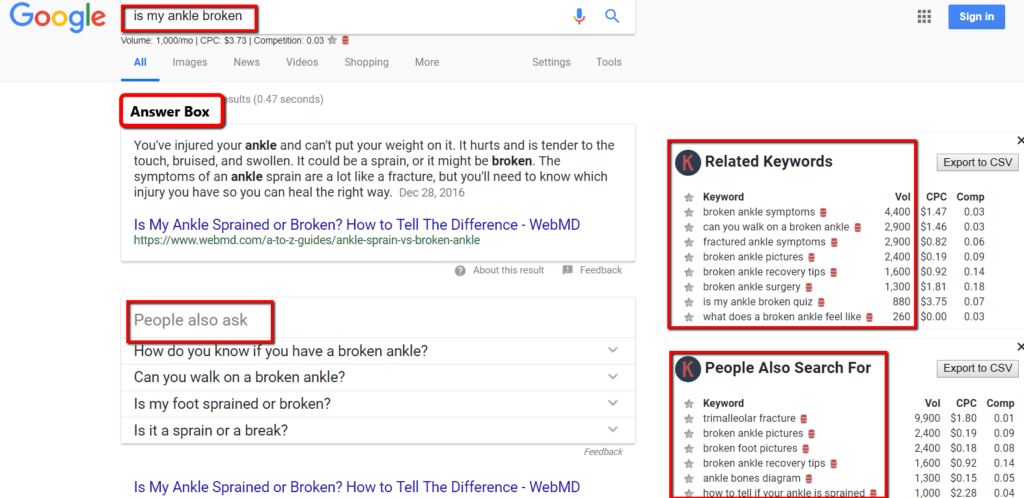
Hospital and Healthcare marketers have the responsibility to increase your opurganization’s visibility, be an authority in condition-related content, and a provide a positive experience when someone lands on your website from a search.
Our recommendations below can be applied to any major industry, but we focused our examples on Hospitals and Healthcare Providers.
Local SEO for Hospitals
When you do a Google search for your hospital, do you see a Knowledge Graph or a Google Map in the search result with 3 – 5 listings?
Hospital Brand (e.g., Tufts Medical Center)
- You will see a Google Knowledge Graph for this type of search.
Location + Hospital (e.g., mass general hospital)
Any hospital with a city or town in the name, you won’t see the Google Knowledge Graph. However, there is a local Google Map result and “See results about” box on the right-rail that generate a Knowledge Graph when clicked.
Verify Your Locations and Doctors on Third-Party Websites
- Are your locations created and verified on Google My Business?
- Are your departments verified in Google My Business?
- Do you have a Wikipedia page for your organization?
- Are you on Yelp? Foursquare? Other location services sites?
- Are your office locations on HealthGrades?
- Are your doctors profiles on HealthGrades?
- Are your locations and doctor profiles on ZocDoc?
- Are your locations and doctor profiles on WebMD?
Location Pages
In addition to verifying your locations in Google My Business, you need information about each of your locations on their own page since you might offer services at one location but not another. Adding location-specific services is also an important SEO signal that could improve your rankings for local searches.
Missed SEO Opportunity for Hospitals
Google My Business for Departments
Departments within businesses, universities, hospitals, and government institutions may have their own listings on Google. Public-facing departments that operate as distinct entities should have their own page. The exact name of each department must be different from that of the main business and that of other departments. Typically such departments have a separate customer entrance and should each have distinct categories. Their hours may sometimes differ from those of the main business.
https://support.google.com/business/answer/3038177?hl=en
Below is an example of how Beth Israel used Google My Business for Departments to increase organic visibility and improve their Knowledge Graph.
Doctor Profile Pages
Make sure each doctor has an HTML page with their photo, specialties, and accreditation. A lot of doctors do not have their own websites and rely on third-party websites to host their credentials. Additionally, most hospital websites have a table that helps visitors filter by specialty.
Does your organization have a Knowledge Graph on Google?
If you don’t have a Google Knowledge Graph, use Organization and Website Schema to help Google, Yahoo, and Bing identify your brand information and social properties to display a better page 1 result for branded searches.
Search Wikipedia for your organization to see if you have enough information, since Google uses information from Wikipedia for their Knowledge Graphs.
A variety of fields can appear on Kcnowledge Graphs for Hospitals:
- Social Profiles
- CEO
- Year Founded
- Stock Ticker
- Number of Employees
- Wikipedia Paragraph and Link
- Business Address
- Opening & Closing Hours
- Appointments
- Reviews
- Logo and Other Photos
- Events
- People Also Searched For (usually your competitors)
- Google and Other Third Party Reviews from the Web (e.g., Yelp and Facebook)
- Popular Times
- Social Profiles
- Directions
- Questions & Answers
- Any Google searcher can ask and answer questions (including your public-facing, personal account).
Create a Blog for Your Hospital
In the business-to-business blogging world, there’s a saying,”write blog posts that get people who are reading them promoted.” It’s drastically different for hospital content writing since your goal is to provide trusted medical information and services for prospective patients, recruit residency applicants, highlight staff accomplishments, and more.
Developing a blog posting schedule will keep you accountable and your content fresh, which is a strong signal for Google to crawl your website more for new content.
SEO Optimization Fundamentals
Meta Data
We don’t need to cover meta data because we already have an excellent blog post explaining the importance of it.
Title Tag Examples
Boston Children’s Hospital: Boston Children’s Hospital
Dana Farber: Dana-Farber Cancer Institute – Cancer Treatment and Research in Boston, MA
Beth Israel: Beth Israel Deaconess Medical Center | BIDMC
Meta Description Examples
Boston Children’s Hospital: Learn about Boston Children’s Hospital, ranked the #1 pediatric hospital in the country by U.S. News and World Report.
Dana Farber: Defeating cancer is our sole mission. At Dana–Farber, you not only get a cancer specialist, but you also get a specialist in your particular type of cancer.
Beth Israel: Beth Israel Deaconess Medical Center (BIDMC) is a world-class teaching hospital of Harvard Medical School located in the heart of Boston. Learn more about our extraordinary care and research.
Choosing Your Target Keywords
Not sure how many keywords to track? Choose 10 “holy grail” keywords that top executives in your organization would want your website to rank on Google. The number of keywords you should track depends on the size of your website; however, for a site with 10,000-30,000 pages, limit yourself to 300 keywords that cover an variety of keyword categories.
Answer more than the query? Instead of having a page that answers, is my “ankle broken?”. Target multiple keywords by providing the answer with each phase of diagnosis and recovery.
Content
Are your conditions pages answering more than just one search intent? Completely cover a condition or service by using “keyword clusters,” which target semantically related keywords that should completely cover the topic.
Example: “Is My Ankle Broken?)
Find opportunities to build out content on each page by comparing your existing content with incoming search data and rankings available using Google Search Console or an enterprise SEO tool.
Advanced SEO: Schema Markup
Schema markup helps you get rich results on desktop and mobile search results on Google, Yahoo, and Bing. Implementing schema markup on a page can help click-through-rates in search results and help Google better identify the content on your page.
Types of Schema Markup You Can Add to a Page
- People
- Location
- Organization
- Jobs
- In 2018, Google developed a partnership with LinkedIn, Glassdoor, Monster, and other services to display job listings as rich snippets in search results.
- Testimonials
- Breadcrumbs
- Navigational Search
- Want a search bar below your Google listing that drives searchers right to your internal search results? Implement the Sitelinks Searchbox. Also, if you have the Stelinks Searchbox and would rather not have it, you can tell Google to remove it with code.
If you host medical articles on your website, use the Schema markup, Medical Scholarly Article, to be eligible for rich snippets within Google Search Results.
Trust and Credibility
Your website is another facet of your brand’s voice. Your visitors expect a well-designed and easy-to-navigate website that conveys credibility; they trust your organization with the well-being of themselves or a family member.
Build Trust
If one of your departments won a U. S. News award for their services or Best Places to Work, embed the badge or award image in the footer or right side-rail of that departments’ pages.
Reputation Management
- Let visitors know they can reach you on their preferred social network with social icons on your website.
- Have you asked for testimonials? Promote your exceptional care and innovative services with testimonials from happy patients.
- Do you have a Better Business Bureau icon?
- Have you earned accreditation or industry awards? Share your accredication and enter your organization in award shows for established trade publications and websites to highlight exceptional departments, doctors, and staff
- Are your contact information and social media channel icons in the footer? Let people contact you anytime with their questions. Most complaints happen online, and it’s important to respond quickly.
What is on Page One of Google for Your Branded Searches?
Look what is on the first page one for the Google search, [Your Company], before your CEO does.
- Want to hide undesirable results on Google’s page one for branded searches? Implement Barnacle SEO to own the first page of Google. The first page of search results for hospitals tend to be a large map of local hospitals, Wikipedia page, image or video carousel of relevant assets, and third-party hospital ranking websites.
- Are your social media accounts on page 1? If not, why do you think so? You are probably not active enough on social media to be an authority that current and future patients use as a resource.
Humanize Your Website
Visitors want to see personality in your website that promotes the hardworking employees in your hospital. Add high-quality, authentic photos of doctors and families and patients (with formal permission). Make sure your images are related to the theme–pictures that look too different across a website will look bad.
ACCESSIBILITY
A lot of traffic to hospital websites are baby boomers researching content about conditions, services offered at each location, accreditation of medical staff, and more. These searchers will be more internet-savvy than your patients but it’s still important to keep your website accessible to anyone.
Accessibility Tips
If you printed out a page on your website, can you still read it?
- Headlines: 38 pixels for headlines is the average.
- Body Copy: 16 pixels is the average.
- Visit your website on a slow mobile internet connection or spotty WiFi.
- If you are frustrated how slow it is, use Google’s PageSpeed Insights for actionable recommendations.
- Navigate your website on a smartphone and take notes on your experience.
- Tip: find the most popular phone for your site visitors via Google Analytics –> Search for information and a version of your checkout (request an appointment, contact us, download information)
Whether you have a mobile-friendly site or not, offer visitors a “View Full Website” button in the footer. Even though you invested money on a well-designed, responsive website, some people prefer the same user interface when browsing on a desktop or mobile device.
Are your phone numbers hyperlinked for mobile devices? This allows a visitor to tap your phone number on a mobile device and immediately call the phone number a representative, instead of having to write it down.
Is it easy to navigate to the Contact Us Page? Find a Doctor Page? Maps and Directions?
How do images on your pages look? There is no reason to use stock photograph of doctors or body diagrams if you want to establish credibility and display your authority in the industry and human-side of your organization.
Optimize for screen readers. There are a variety of tools and browser plugins available to test your website’s accessibility.
TRANSLATION
Look at your site traffic by language and make plans to translate important pages or your entire website.
Few hospitals have translated their websites to Arabic, Mandarin and Spanish (common languages for hospital visitors) with the different language options available in the navigation. Start with the high priority pages–you don’t have to immediately translate every page on your site. Monitor their user engagement and rankings on Google and decide to invest more resources into translated content. Make sure an Arabic-speaking person visits the Arabic-translated page from Google search results with language targeting called Href Lang Tags. You can implement these in the <head> of each page, or in your XML Sitemap.
IMPROVING CONVERSIONS
You need to define your key performance indicators (KPIs) with your stakeholders. Identifying and tracking your conversions is also important to optimize each marketing channel’s performance and changing tactics after analyzing the results. You should experience year-over-year conversion metric increases for most marketing channels if you’re monitoring and investing resources in them.
Additionally, make sure there are micro (e.g., videos and downloads) and macro (e.g., book appointment, consultation, find a doctor) calls-to-actions on each page to satisfy every stage of the buying cycle.
Popular Hospital Calls-to-Action
- Schedule a Visit
- Consultation
- Find a Doctor
Catalog all of your calls-to-action and assets on your website to find gaps, or ask us to do it!
User Segmentation: Improve your analytics tracking by segmenting visitors that are relevant your target users. The most important aspect of segmenting visitor traffic is what you need to segment out. For example, if you are a local hospital, you should pay less attention to international visitor traffic and metrics.
Talk with your internal teams! Make data-driven decisions by speaking internally and asking what data sources are coming in, what else can you track, what is the most important metrics tracked, what is success for your upper management.



